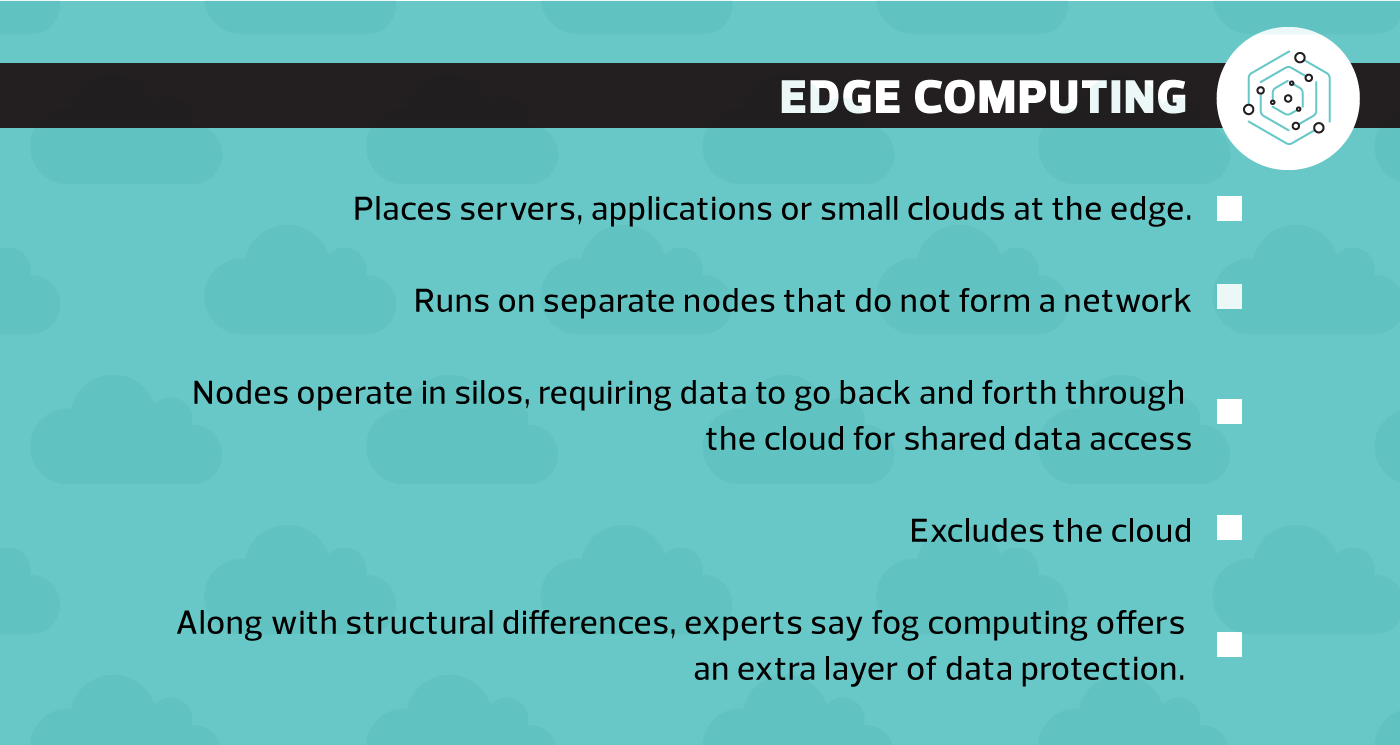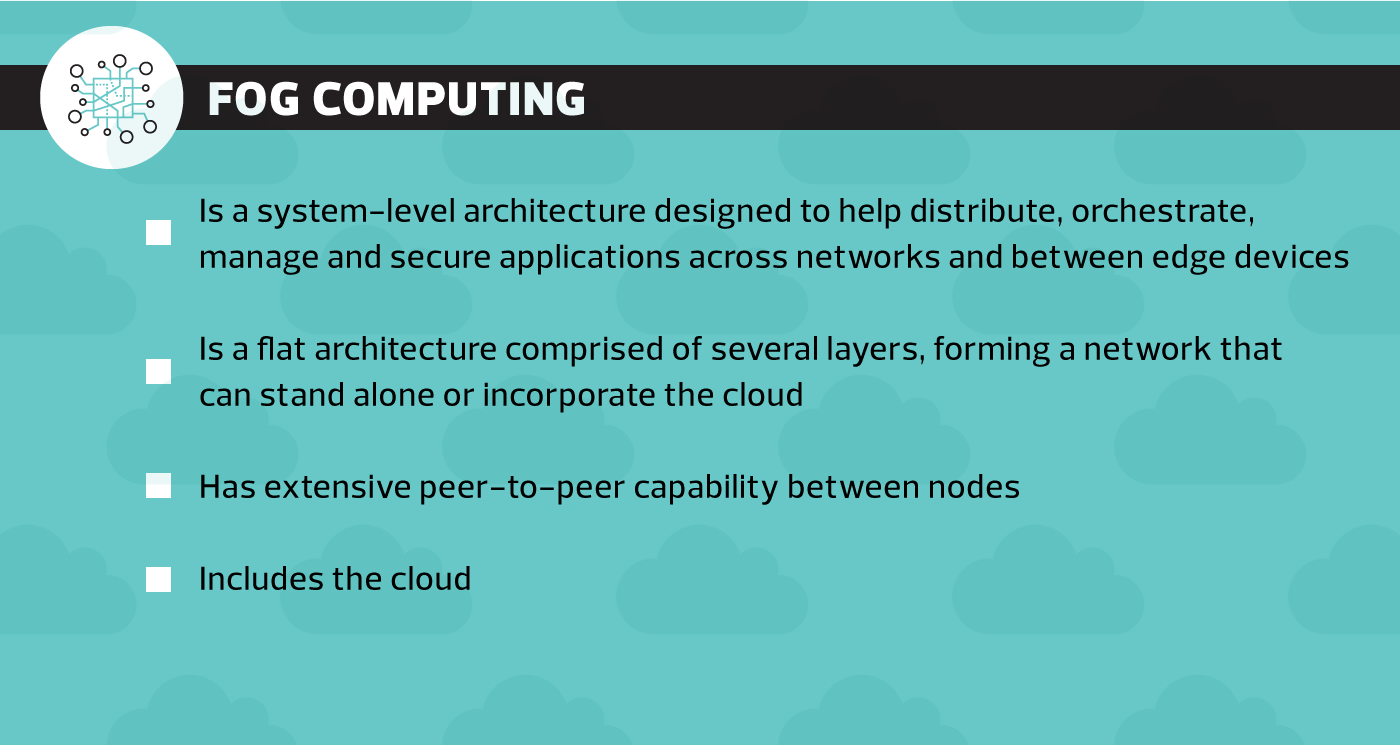New forms of computing infrastructure — fog computing and edge computing — are entering IT conversations in higher education as universities expand Internet of Things applications on their campuses.
Many campuses already incorporate a variety of cloud computing solutions, using cloud’s flexible scalability to easily control and adapt campus networking to fit specific needs.
In fact, experts forecast the market for cloud computing on campus to increase by 26 percent in 2021.
Cloud computing can be great for more robust data storage, computing and security. Where fog computing versus edge computing comes into play will depend on the needs of each campus.
MORE FROM EDTECH: Fog computing promises faster data analytics.
What Is Fog Computing?
Fog computing is an emerging structure for computing, storing and securing information beneath the cloud layer. It allows these actions to be spread more evenly across the network and not just on a central node.
Fog computing versus cloud computing requires information to be sent back and forth from IoT devices to a central system, to store and compute data on nodes closer to the data source.
Less space to travel means a significant reduction in latency, in some cases from 100 milliseconds to less than one.
For higher education, fog computing could be a powerful support for applications requiring faster data speeds, such as artificial intelligence, mixed reality devices, high-performance computing and even 5G network integration.
According to Cisco, which coined the term in 2014, fog computing is “a standard that defines how edge computing should work, and it facilitates the operation of compute, storage and networking services between end devices and cloud computing data centers.”
On campuses, fog computing could help universities install smart building infrastructure, including in-ground vehicle detection for parking spaces and smarter, more secure entry systems.
Some of the smart city applications for fog computing could also be applied to campuses. This could include monitoring traffic on roads running through and around campus and using real-time security cameras.
Some universities have already started to research applications that could benefit from fog computing, including autonomous vehicles, agriculture technology and remote surgery.
At the University of Arizona, Marwan Krunz, a professor in the department of electrical and computer engineering, is leading a team funded by 15 technology companies to study the applications of fog computing across industries, according to EurekaAlert.
Meanwhile, at Duke University, experts believe fog computing could potentially lead to responsive augmented reality, or holograms, on campus.
“Fog offers a natural chokepoint for reducing the resources consumed on mobile nodes in multi-user settings, as well as a natural point for making those experiences more intelligent,” Maria Gorlatova, a Duke electrical and computer engineering professor, said at Fog World Congress this year.
What is Edge Computing?
With edge networks, data storage and computing are kept close to the device, application or human that produces the data being handled.
For IoT-connected devices that generate large quantities of data, this can be extremely helpful in cutting down the time it would take to send data back and forth to a cloud network.
Edge computing has already started to improve a number of higher education functions, from network traffic management to the quality of the end-user experience.
In 2017, the University of Notre Dame and Nokia partnered to bring multi-access edge computing to the university’s Compton Ice Arena.
Using a combination of Wi-Fi access points, Nokia’s MEC platform and its AirFrame server, the stadium was able to stream video on four separate platforms within a 500-millisecond delay of each other.
Recently, Carnegie Mellon University and Microsoft agreed to collaborate on research around edge computing.
The technology giant is giving Carnegie Mellon edge computing products, including Azure Data Box Edge, Azure Stack and Microsoft Azure credits. The hardware will be powered by Intel Xeon Scalable processors.
These new tools will go to Carnegie Mellon’s designated edge computing laboratory. There, students and faculty will push Microsoft’s equipment to see what their capabilities are.
MORE FROM EDTECH: 2019 tech trends expected to hit higher education in 2019.
Fog Computing vs. Edge Computing: What Is the Difference?
If it sounds like edge computing and fog computing are similar, it is because they are. However, while fog computing always uses edge computing, the opposite is not always true.
The OpenFog Consortium, a global partnership working to improve fog applications founded by Cisco, Dell, Intel, Microsoft, Princeton University and ARM, a United Kingdom chip company, notes a few key differences:
Drag the arrows to see the difference between fog and edge computing.
Fog Computing Improves IoT Security on Campus
According to the OpenFog consortium, there are five ways fog computing can uniquely improve endpoint security:
- Since fog computing works with the cloud and not outside of it, it acts as an added layer of security between IoT devices and the server beyond.
- The fog network can monitor the smaller, simpler devices that were not necessarily built with their own cybersecurity capabilities. This means small IoT sensors can rely on the fog network to handle the bulk of the security responsibilities.
- Fog devices are designed to manage updates on a large number of devices simultaneously, unlike cloud networks, which require devices to connect to the cloud each time.
- Fog networks can accurately monitor the security status of distributed systems on campus.
- Fog networks offer real-time incident reports for connected IoT systems and allow for IT teams to respond to breaches without shutting down essential system elements.
Experts say fog computing is further away from widespread adoption than edge computing. However, universities are excited at the prospects this new computing structure could bring.
“Fog and edge could create a tipping point, of sorts,” writes David Linthicum, chief cloud strategy consultant for Deloitte consulting. “Placing a micro-platform at the IoT device, as well as providing tools and approaches to leverage this platform, will likely expand the capabilities of IoT systems and provide more use cases for IoT in general.”










